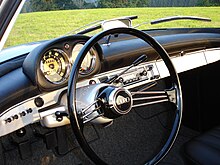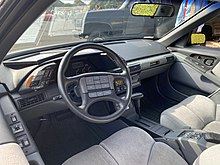Steering wheel
Steering wheels are used in most modern land vehicles, including all mass-production automobiles, buses, light and heavy trucks, as well as tractors and tanks.Charles Rolls introduced the first car in Britain fitted with a steering wheel when he imported a 6 hp Panhard from France in 1898.[4] Arthur Constantin Krebs replaced the tiller with an inclined steering wheel for the Panhard car he designed for the 1898 Paris–Amsterdam–Paris race which ran 7–13 July 1898.[14] The objective of the flat bottom is to ease diver egress while the flattened top enhances the line of sight when driving.[14] General Motors applied for a US patent for a modular steering control that can be updated with components or changed in shape ranging from a traditional circle to a yoke.A typical design for circular steering wheels is a steel or magnesium rim with a plastic or rubberized grip molded over and around it.Some drivers purchase vinyl or textile steering wheel covers to enhance grip and comfort or simply as decoration.Without interior cabin packaging constraints, they tended to be made as large a diameter as possible to reduce the effort needed to turn.As cars grew progressively lower and driver's areas more compact throughout the 1960s and 1970s, steering wheels became smaller to fit into the interior space.The wheel can be adjusted upward or downward by disengaging the ratchet lock while the steering column remains stationary below the joint.[27][30] In 1949, the Jaguar XK120 introduced a new steering wheel supplied by Bluemel that was driver-adjustable by loosening a sleeve around the column by hand.The GM column was released by twisting a locking ring surrounding the center hub and offered a 3-inch (76 mm) range of adjustment.In 1966, Ford offered the Highway Pilot Speed Control option with steering wheel pad-mounted rocker switches, on its Thunderbird.[40] Uniquely, the Thunderbird also lightly applied the brakes and illuminated the stop lamps when the Retard was continuously depressed with the cruise control on, but not engaged.[41] In 1988, Pontiac offered a steering wheel with 12 buttons controlling various audio functions on the Trans-Am,[42] 6000 STE and Bonneville.Scroll wheels or buttons are often used to set volume levels or page through menus and change radio stations or audio tracks.
















ship's wheeltractorVDL Bovasteeringvehiclesautomobilestractorsrecirculating ballrack and pinionhydraulic power steeringtillerParis–RouenPanhardCharles RollsArthur Constantin Krebs1898 Paris–Amsterdam–ParisThomas B. JefferyRamblersCitroën DSbrodie knobRHD-mountedairbagcruise controlsteering columnspokescountries where cars must drive on the left side of the roadpaddle-shifterssteering columnsimpalingPower steeringelectrical systemsStudebakersMercury Park LaneU.S. Department of Transportationmotor vehicle theftignitionsteering lockVolkswagen BeetleMcLaren F1ergonomicsmagnesiumDKW MonzaAMC MatadorJaguar XK120Ford ThunderbirdGeneral MotorsNexteer AutomotiveCadillacsFederal Motor Vehicle Safety Standardsbolt circledry steeringFormula Onedashboardslip ringRim BlowThunderbirdContinentalBonnevillevehicle audiovoice controlScrollcontrolsPlayStation 2racing wheelGame controllersarcade cabinetsconsole gamesracing gamesTelstar Arcadeforce feedbacktactile feedbackList of auto partsRemote controlAutomotive designFrameworkBackbone chassisBeltlineBody-on-frameBumperDagmarCabrio coachChassisContinental tireCrumple zoneFenderpontonskirtsGrilleshakerMonocoqueOverhangPillarPlatformQuarter panelSpoilerStressed member engineSubframeTonneauTrunk lidHood/bonnetTrunk/boot/dickieButterflyCanopyGull-wingScissorSlidingSuicideGlass run channelGreenhouseOpera windowPower windowQuarter glassSunroofWindshield/windscreenwasher fluidBumper stickerCurb feelerFront-end braHood ornamentInstrumentsJapan blackNerf barOmniview technologyTire/tyrerun-flatApproach and departure angles